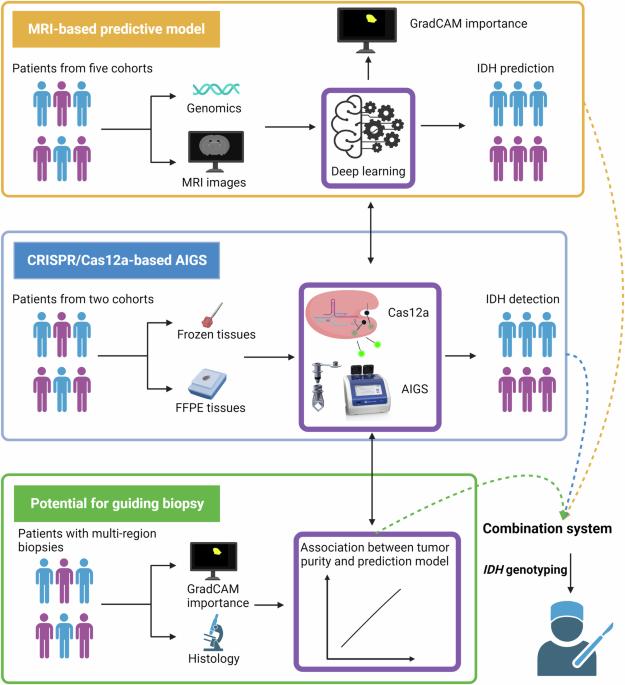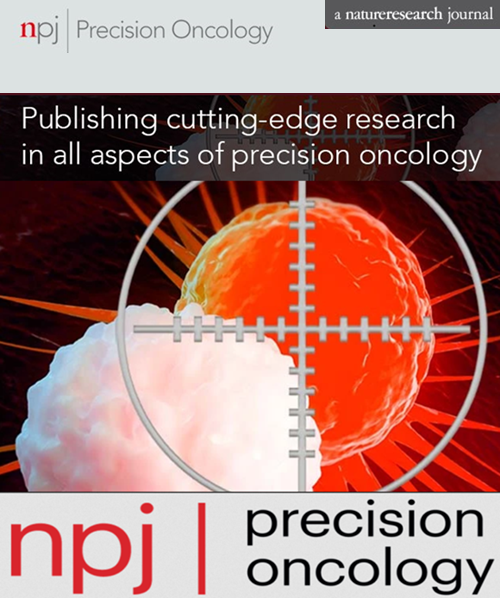Combination of MRI-based prediction and CRISPR/Cas12a-based detection for IDH genotyping in glioma
IF 6.8
1区 医学
Q1 ONCOLOGY
引用次数: 0
Abstract
Early identification of IDH mutation status is of great significance in clinical therapeutic decision-making in the treatment of glioma. We demonstrate a technological solution to improve the accuracy and reliability of IDH mutation detection by combining MRI-based prediction and a CRISPR-based automatic integrated gene detection system (AIGS). A model was constructed to predict the IDH mutation status using whole slices in MRI scans with a Transformer neural network, and the predictive model achieved accuracies of 0.93, 0.87, and 0.84 using the internal and two external test sets, respectively. Additionally, CRISPR/Cas12a-based AIGS was constructed, and AIGS achieved 100% diagnostic accuracy in terms of IDH detection using both frozen tissue and FFPE samples in one hour. Moreover, the feature attribution of our predictive model was assessed using GradCAM, and the highest correlations with tumor cell percentages in enhancing and IDH-wildtype gliomas were found to have GradCAM importance (0.65 and 0.5, respectively). This MRI-based predictive model could, therefore, guide biopsy for tumor-enriched, which would ensure the veracity and stability of the rapid detection results. The combination of our predictive model and AIGS improved the early determination of IDH mutation status in glioma patients. This combined system of MRI-based prediction and CRISPR/Cas12a-based detection can be used to guide biopsy, resection, and radiation for glioma patients to improve patient outcomes.

结合基于磁共振成像的预测和基于 CRISPR/Cas12a 的检测,对胶质瘤进行 IDH 基因分型。
早期识别IDH突变状态对胶质瘤的临床治疗决策具有重要意义。我们展示了一种技术解决方案,通过结合基于核磁共振成像的预测和基于CRISPR的自动综合基因检测系统(AIGS),提高IDH突变检测的准确性和可靠性。该预测模型在内部和两个外部测试集中的准确率分别达到了 0.93、0.87 和 0.84。此外,我们还构建了基于CRISPR/Cas12a的AIGS,该AIGS在一小时内使用冷冻组织和FFPE样本对IDH的检测达到了100%的诊断准确率。此外,我们还使用 GradCAM 评估了预测模型的特征归属,发现 GradCAM 与增强型和 IDH 野生型胶质瘤中肿瘤细胞百分比的相关性最高(分别为 0.65 和 0.5)。因此,这种基于磁共振成像的预测模型可以指导肿瘤富集的活检,从而确保快速检测结果的真实性和稳定性。我们的预测模型与 AIGS 的结合提高了对胶质瘤患者 IDH 突变状态的早期判断。这种基于核磁共振成像的预测和基于CRISPR/Cas12a的检测相结合的系统可用于指导胶质瘤患者的活检、切除和放射治疗,从而改善患者的预后。
本文章由计算机程序翻译,如有差异,请以英文原文为准。
求助全文
约1分钟内获得全文
求助全文
来源期刊

NPJ Precision Oncology
ONCOLOGY-
CiteScore
9.90
自引率
1.30%
发文量
87
审稿时长
18 weeks
期刊介绍:
Online-only and open access, npj Precision Oncology is an international, peer-reviewed journal dedicated to showcasing cutting-edge scientific research in all facets of precision oncology, spanning from fundamental science to translational applications and clinical medicine.
 求助内容:
求助内容: 应助结果提醒方式:
应助结果提醒方式:


